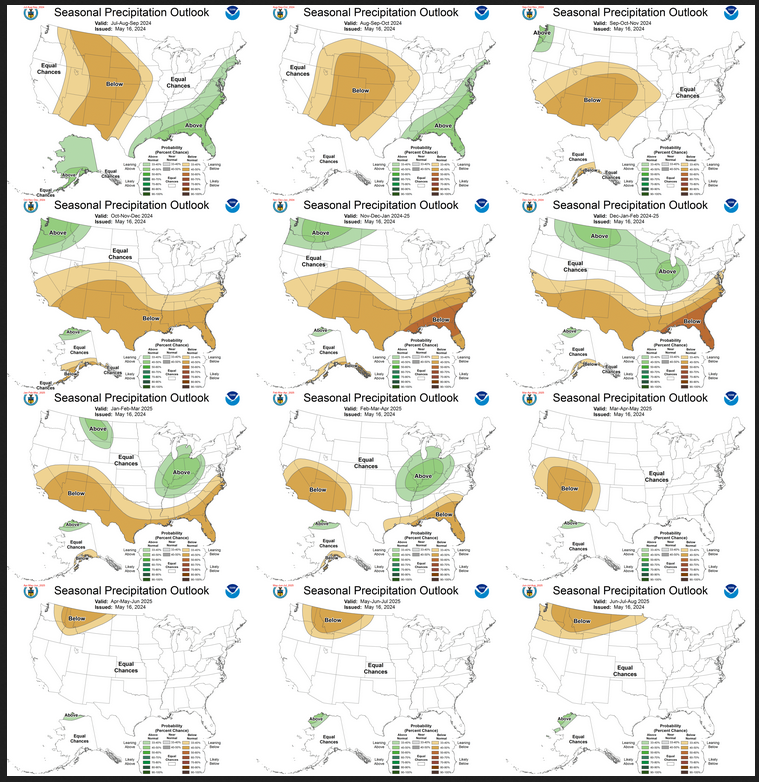On the third Thursday of the month right on schedule NOAA issued their updated Seasonal Outlook which I describe as their Four-Season Outlook because it extends a bit more than one year into the future. The information released also included the Mid-Month Outlook for the following month plus the weather and drought outlook for the next three months. I present the information issued by NOAA and try to add context to it. It is quite a challenge for NOAA to address the subsequent month, the subsequent three-month period as well as the twelve successive three-month periods for a year or a bit more.
With respect to the long-term part of the Outlook which I call the Four-Season Outlook, there is a rapid transition from Neutral to LaNina. So getting the timing right is challenging. We are now in ENSO Neutral. La Nina is the likely scenario for this summer almost to the end of the forecast period. The Outlook beyond June has not been significantly changed from what was issued last month. This suggests increasing confidence in the outlook. The forecast is a canonical La Nina plus trends.
First, Let’s Take a Look at the (mid-month) Outlook for July

It will be updated on the last day of June.

The top row is what is now called the Mid-Month Outlook for next month which will be updated at the end of this month. There is a temperature map and a precipitation map. The second row is a three-month outlook that includes next month. I think the outlook maps are self-explanatory. What is important to remember is that they show deviations from the current definition of normal which is the period 1991 through 2020. So this is not a forecast of the absolute value of temperature or precipitation but the change from what is defined as normal or to use the technical term “climatology”.
| Notice that the Outlook for next month and the three-month Outlook are somewhat different, especially about precipitation. This tells us that August and September will be different than July to some extent. |
| The expansion of the area impacted by drought is extensive. |

The full NOAA Seasonal Outlook extends through July/August/September of 2025 (yes that is more than a year out). All of these maps are in the body of the article. Large maps are provided for July and the three-month period July/August/September. Small maps are provided beyond that through July/August/September of 2025 with a link to get larger versions of these maps.
NOAA provides a discussion to support the maps. It is included in the body of this article. In some cases, one will need to click on “read more” to read the full article. For those on my email list where I have sent the url of the article, that will not be necessary.
Here are larger versions of the Temperature and Precipitation Outlook maps for next month.
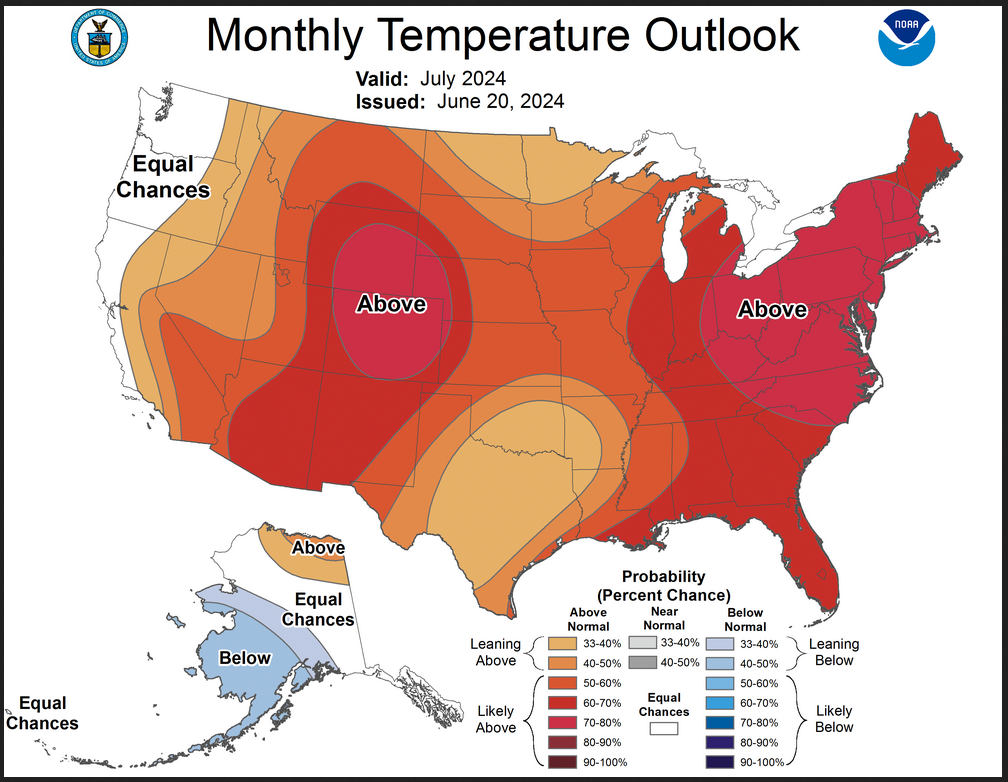
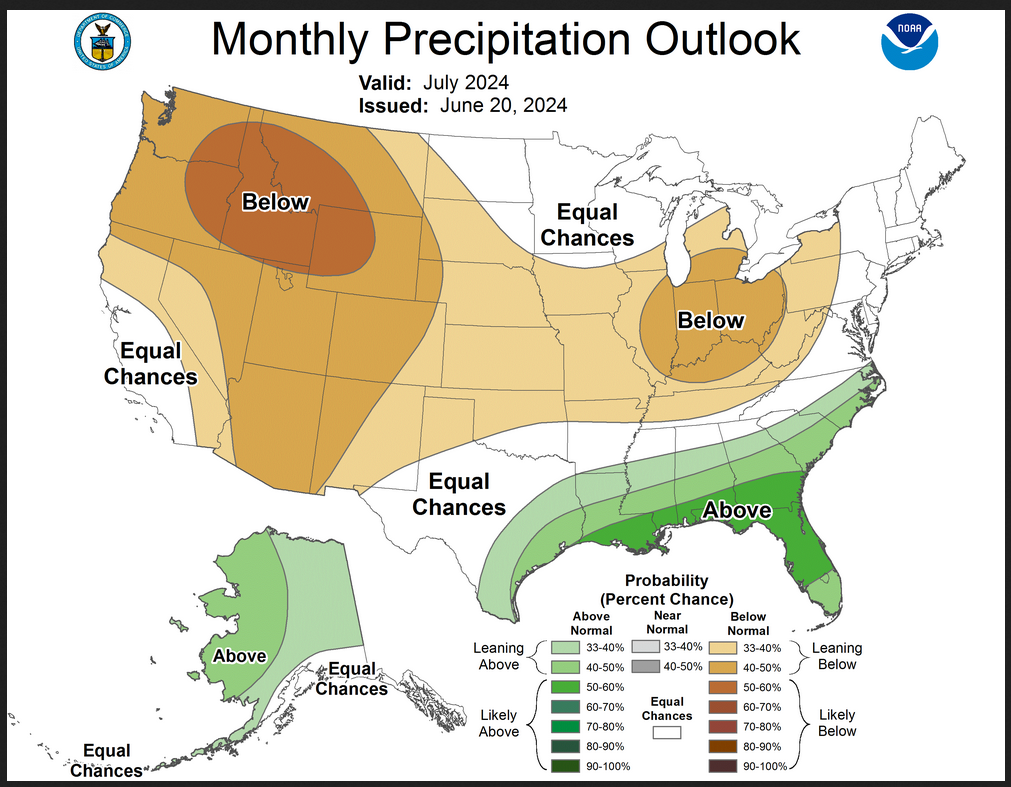
The maps are pretty clear in terms of the outlook.
And here are large versions of the three-month JAS 2024 Outlooks
First temperature followed by precipitation.
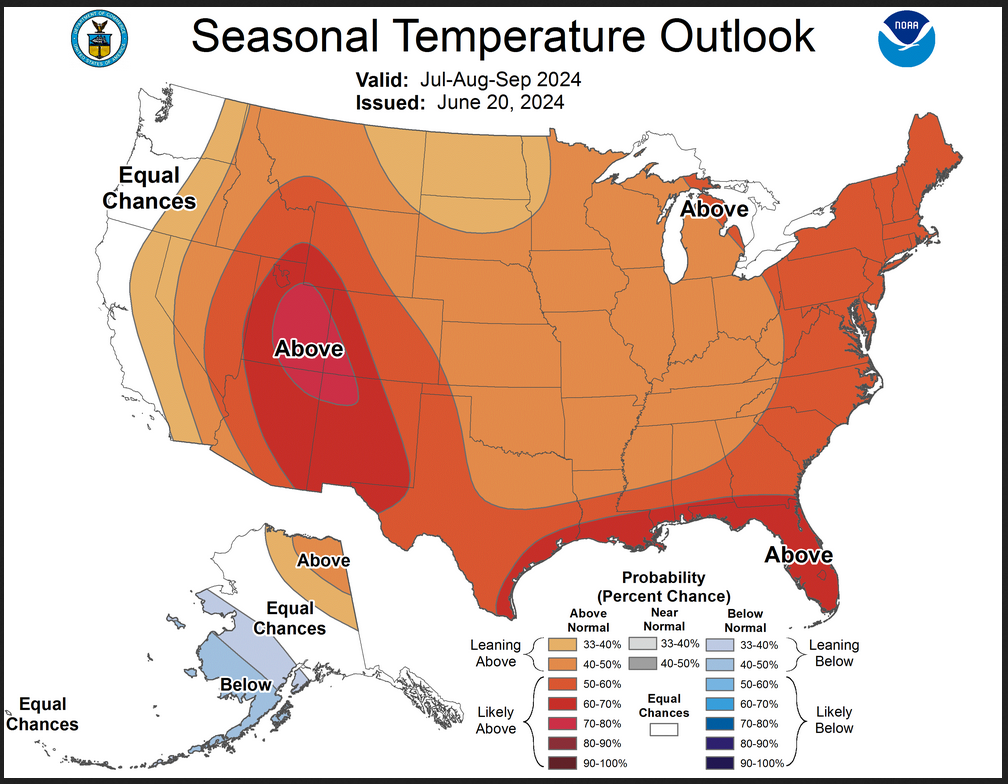
| These maps are larger versions of what was shown earlier. This is a pretty definitive pattern. |
Drought Outlook
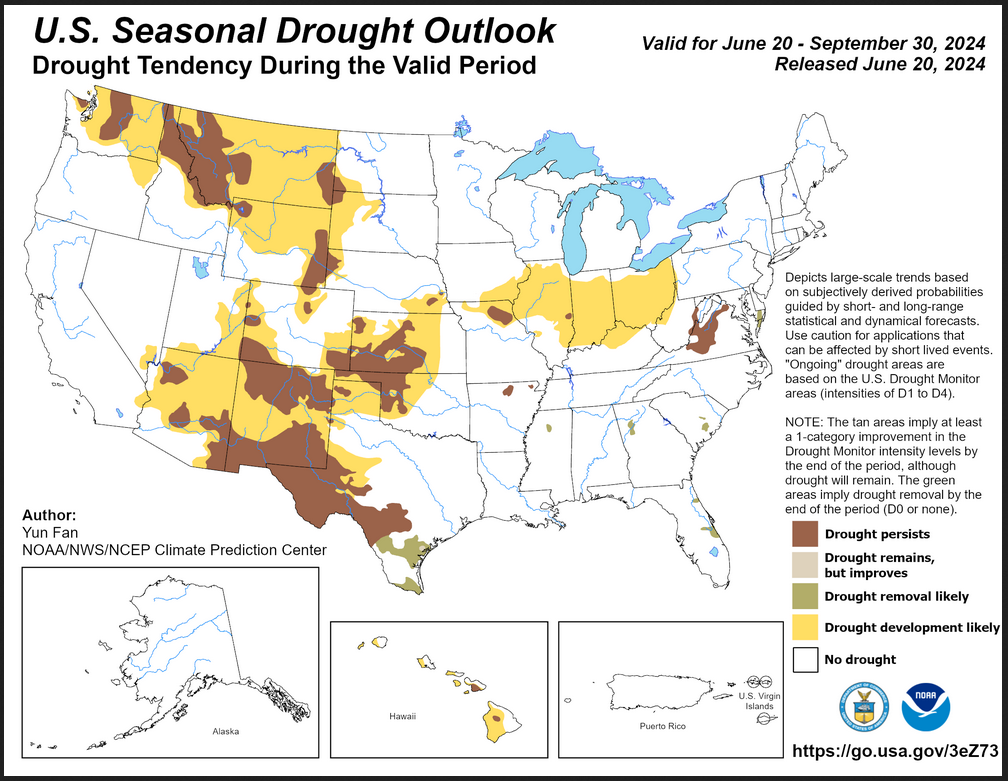
| The yellow is the bad news and there is a lot of it. And there is a large area where drought is expected to persist. Overall the level of drought is expected to increase significantly And with a subpar Monsoon and a La Nina winter ahead, it is likely to go higher. |
Short CPC Drought Discussion
Latest Seasonal Assessment – For the past 4 weeks, widespread beneficial rainfall across the contiguous U.S. (CONUS) brought 1-3 class drought improvement or removal over portions of the western Midwest, Great Plains, West and Southeast. However, several locations did miss out on meaningful precipitation, especially across portions of HighPlains, where anomalous dryness and moderate to severe drought developed. Rapidly moderate to extreme (1-3 class) drought development was also observed over parts of the central-southern Florida Peninsula and then its southern portion was wiped out by extreme heavy rainfall recently. Pockets of abnormally dry and moderate drought conditions have also newly developed and/or expanded across parts of the Mid-Atlantic, Mississippi, Alabama, Georgia and Carolinas.
Looking forward to the July-August-September (JAS) SDO, drought persistence is favored with drought development likely across northern portions of the West, due to predicted below normal precipitation and above normal temperatures across much of the areas, being the climatologically dry time of year and favorable time of year for soil moisture discharge. Drought persistence and development are forecast across the Southwest Central and Southern Plains, due to forecast below normal precipitation and above normal temperatures across much of the region. Parts of the Southwest also enter their climatologically wet (monsoon) season and favorable time of year for soil moisture recharge. However, uncertainty remains greatest across portions of this region, due to the sporadic nature of thunderstorm activity during the monsoon season. Areas not seeing precipitation will likely experience degrading or expanding drought conditions. Drought persistence and redevelopment are likely across parts of the Ohio Valley due to lack of wet signals in the precipitation outlooks coupled with above normal temperatures over the region. Drought removal is expected for the Florida Peninsula, with forecast above normal precipitation outlooks and favorable time of year for soil moisture recharge. Drought removal is also likely for the existing moderate drought along the coastal Atlantic regions due to favorable precipitation outlooks across the areas in the JAS season.
Alaska is likely to remain drought-free, due to favorable precipitation outlooks for July and JAS. In Hawaii, drought persistence is forecast with drought development likely along leeward sides of the Islands, given predicted below normal precipitation, the antecedent dryness, JAS being a very dry time of year, and the potential for ENSO to transition toward La Niña conditions (i.e. colder than normal sea surface temperatures in the central tropical Pacific) toward the end of September. Conversely, antecedent wet conditions, very wet precipitation outlooks for July and JAS, and the potential for tropical activity are likely to keep Puerto Rico and the U.S. Virgin Islands (USVI) drought-free through the end of September.
Looking out Four Seasons.
Twelve Temperature Maps. These are overlapping three-month maps (larger versions of these and other maps can be accessed HERE)
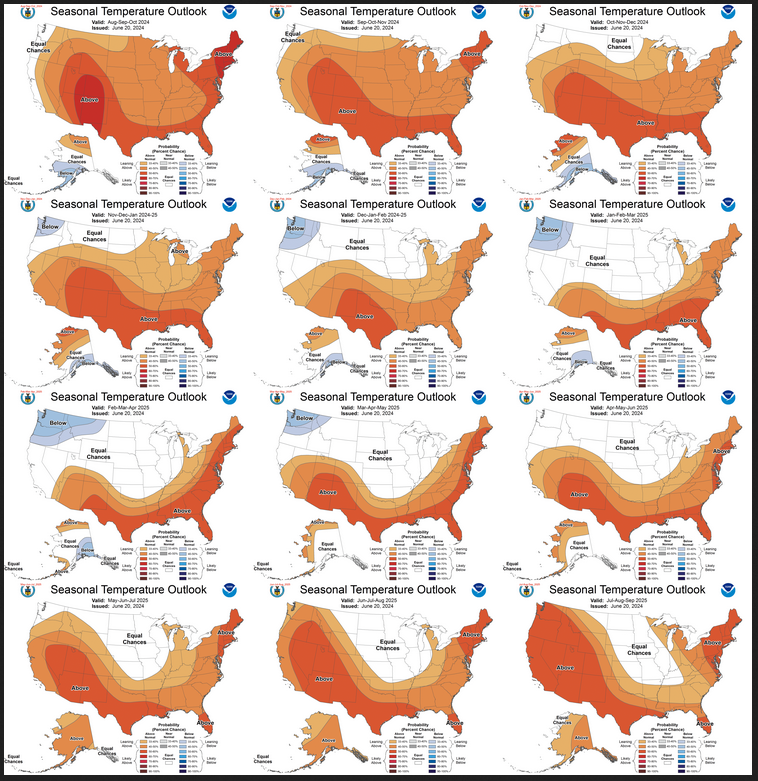
Notice that this presentation starts with Aug/Sep/Oct (ASO) since JJA is considered the near-term and is covered earlier in the presentation. The changes over time are generally discussed in the discussion but you can see the changes easier in the maps.
Comparing the new outlook with the prior Outlook,

The easiest way to do the comparison is to print out both maps. If you have a color printer that is great but not needed. What I do is number the images from last month 1 – 12 starting with “1” and going left to right and then dropping down one row. Then for the new set of images, I number them 2 – 13. That is because one image from last month in the upper left is now discarded and a new image on the lower right is added. Once you get used to it, it is not difficult. In theory, the changes are discussed in the NOAA discussion but I usually find more changes. It is not necessarily important. I try to identify the changes but believe it would make this article overly long to enumerate them. The information is here for anyone who wishes to examine the changes. I comment below on some of the changes from the prior report by NOAA and important changes over time in the pattern.
| There has not been much of a change since last month. |
Now the Twelve New Precipitation Maps
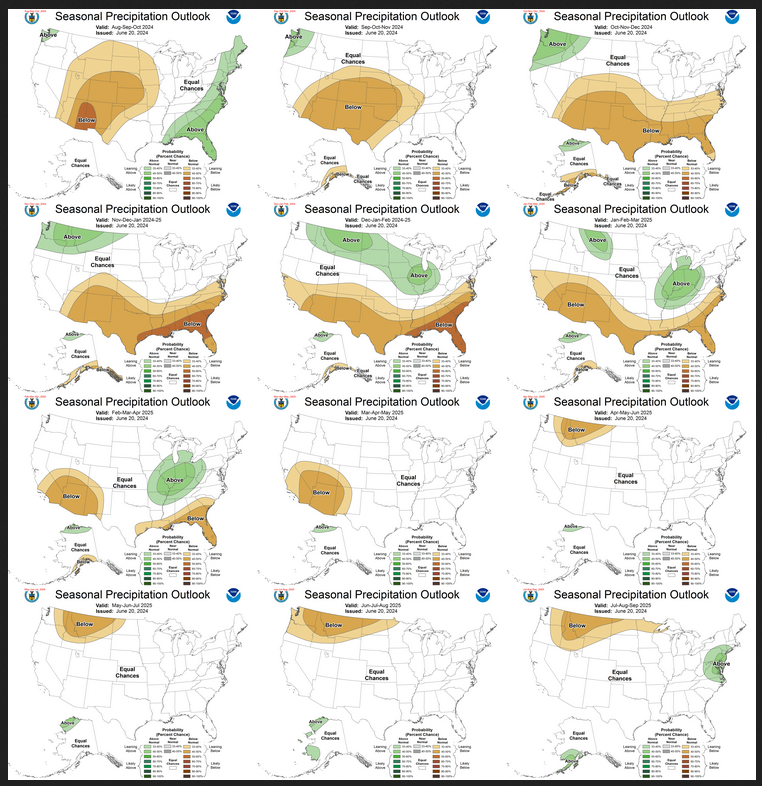
Similar to Temperature in terms of the organization of the twelve overlapping three-month outlooks.
Comparing the new outlook with the prior Outlook,
The maps that were released last month.
A good approach for doing this comparison is provided with the temperature discussion.
| The overall outlook is the same as last month. |
NOAA Discussion
Maps tell a story but to really understand what is going you need to read the discussion. I combine the 30-day discussion with the long-term discussion and rearrange it a bit and add a few additional titles (where they are not all caps the titles are my additions). Readers may also wish to take a look at the article we published last week on the NOAA ENSO forecast. That can be accessed HERE.
I will use bold type to highlight some especially important things. All section headings are in bold type; my comments, if any, are enclosed in brackets [ ].
CURRENT ATMOSPHERIC AND OCEANIC CONDITIONS
ENSO-neutral conditions returned during the past month, and SSTs in the Niño3.4 region recently dropped to 0.0 degrees Celsius. SSTs in Niño4 remain mildly above normal at 0.6 degrees Celsius, while Niño3 has dropped to -0.2 degrees Celsius and Niño1+2 to -0.6 degrees Celsius. More generally, in the last four weeks, equatorial SSTs were above average in the west-central Pacific Ocean and near-to-below-average SSTs were evident in the east-central and eastern Pacific Ocean. Collectively, the coupled ocean-atmosphere system reflected ENSO-neutral conditions, and there has been a slight slowdown in the rate of cooling since last month.
Starting in November 2023, positive subsurface temperature anomalies weakened to near zero. From late January to mid-April 2024, negative temperature anomalies emerged at the surface and strengthened. Over the last month, negative anomalies have weakened slightly, but dominate the eastern half of the equatorial Pacific Ocean.
The Madden Julian Oscillation (MJO) recently weakened and there was little activity during the first half of June, and dynamical model forecasts of the Realtime Multivariate MJO index through the end of June are generally incoherent. As La Niña is favored to develop during JAS 2024 and persist through winter 2025, La Niña is considered the dominant extratropical influence on the forecast.
Outside of the equatorial Pacific, SST anomalies are below normal near the Alaska coast, particularly off the west coast of the state. Weak, below normal SST anomalies are also observed along the west coast of the CONUS, though they are weak and spotty. Strong above normal SST anomalies are present in the Gulf of Mexico and up much of the East Coast of the CONUS. Soil moisture varies across much of the CONUS but is notably anomalously low over much of New Mexico and southwestern Texas.
PROGNOSTIC DISCUSSION OF SST FORECASTS
The CPC Niño3.4 SST consolidation forecast favors a transition to a La Niña state by JAS 2024. Below zero SST anomalies are forecast in the mean of most inputs to the consolidation through April-June 2025 (AMJ). Forecast plumes of the Niño3.4 index from the North American Multi-Model Ensemble (NMME) generally indicate below zero SST anomalies from July 2024 through January 2025, though some models and ensemble members indicate ENSO-neutral conditions – for example, the GFDL-SPEAR model has a number of ensemble members with anomalies that stay near or slightly above zero degrees Celsius. The CPC Probabilistic ENSO outlook favors ENSO-neutral in May-July 2024 (MJJ) and June-August 2024 (JJA), with chances of La Niña developing in JAS (65% chance) and persisting through the Northern Hemisphere winter 2024-25.
30-DAY OUTLOOK DISCUSSION FOR JULY 2024
In constructing the temperature and precipitation outlooks for the contiguous U.S. (CONUS) and Alaska (AK) for July 2024, we first examine the equatorial Pacific. Sea surface temperature (SST) anomalies have trended toward El Niño Southern Oscillation (ENSO) neutral conditions, with Niño3.4 anomalies near 0 deg C. In the eastern Pacific, both surface and subsurface heat anomalies are now negative, supporting the likely development of La Niña conditions as the summer progresses. The Madden-Julian Oscillation (MJO) is currently disorganized and most dynamical model ensemble guidance forecasts it to remain incoherent through the remainder of June. Even if ENSO and MJO forcing were forecast to be strong, it is typical in summertime for their teleconnections to be less robust due to the northward displacement and weakening of the subtropical jet which leads to a diminished Rossby wave source. Thus, for this outlook, neither ENSO nor the MJO play a substantial role.
Instead, we turn toward extratropical forcings such as coastal SST anomalies, soil moisture anomalies, and the long-term trend. Coastal SST anomalies are currently negative along the western and southern coasts of AK. Near CONUS, they are also negative along the West Coast while they are positive along the East Coast and Gulf Coast. An inspection of current soil moisture anomalies and next week’s expected rainfall indicates an enhanced likelihood of a broad swath of below normal soil moisture conditions stretching from the Southern Plains to the Mid-Atlantic and from the Lower Great Lakes to the Southeast. Above normal soil moisture anomalies are anticipated in Southern Texas and the Upper Mississippi Valley where heavy rainfall is forecast over the next week. Long-term precipitation trends are toward drier conditions in western CONUS and toward wetter conditions along the mid-Atlantic and New England during July. The long-term temperature trend is positive everywhere in CONUS and AK.
A survey of the dynamical models (ECMWF, GEFSv12, CFSv2, and multi-model suites from the NMME and C3S) reveals a strong consistency with the extratropical forcings along with a strong agreement amongst each other. Thus, the confidence level for the July 2024 outlook, including both spatial coverage and the strength of the probabilities, is relatively high. As we enter July, the dynamical models depict above normal 500-hPa heights centered over the East, with near normal heights over AK and the Pacific Northwest. There is some indication that the center of above normal heights will transition westward during the month to become more located over the Intermountain West.
For AK, the temperature outlook is for elevated odds of below normal temperatures over the southwest Mainland and Aleutians where coastal SSTs are below normal and height anomalies indicate the presence of northwesterly flow. Above normal temperatures are favored along the eastern portions of the North Slope, supported by strong long-term trends in that region. Precipitation anomalies are consistent with the temperature outlook, where above normal precipitation is favored over most of AK with the exception of the southern coast where off-shore flow may dominate.
Temperature
For CONUS, above normal temperatures are broadly favored with two centers of 70-80% probabilities featured over the Mid-Atlantic and the Rockies. The Mid-Atlantic is expected to begin July under strong mid-level ridging and below normal soil moisture anomalies, which should lead to above normal temperatures in the region. As the ridge retrogrades westward, above normal temperatrures are likely in the Rockies. Odds for above normal temperatures are considerably lower in the Pacific Northwest, coastal California, the Upper Mississippi Valley, and portions of Texas. In the Pacific Northwest, equal chances (EC) of above, near, or below normal temperatures is forecast due to the expected troughing to begin the month of July. Over coastal California, EC is also favored due to the below normal coastal SSTs leading to the possibility of an enhanced sea breeze. In the Upper Mississippi Valley, positive soil moisture anomalies and a relatively weaker long-term trend lower the odds of above normal temperatures. Above normal soil moisture anomalies also lead to lowered probabilities of above normal temperatures in Texas.
Precipitation
The precipitation outlook over CONUS is less confident than the temperature outlook, which is typical during the summer months due to the stochastic nature of convection and the uncertainty of any impacts from tropical cyclones. Nevertheless, given the expected positive height anomalies and relatively decent model agreement, below normal precipitation is favored over most of the northern two thirds of CONUS. Higher probabilities are centered over the Ohio Valley and Intermountain West, in agreement with the temperature outlook, the expected placement of 500-mb height anomalies, and dry soil conditions in the East. A thin band of EC was maintained along the East Coast due to positive long-term trends , and, while an outlier, the ECMWF is forecasting above normal precipitation along the East Coast. Over the Desert Southwest, most dynamical model guidance is forecasting a weaker southwest monsoon, leading to enhanced below normal probabilities there. Finally, above normal precipitation is favored along the Gulf Coast states, as forecast by most dynamical models and supported by the expected above normal tropical cyclone activity this year.
SUMMARY OF THE OUTLOOK FOR NON-TECHNICAL USERS (Focus on July – September)
The final El Niño Advisory was recently issued in the 17 June 2024 El Niño Southern Oscillation (ENSO) Outlook. Currently, ENSO-neutral conditions are present with equatorial sea surface temperatures (SSTs) above average in the west-central Pacific Ocean, near average in the east-central Pacific Ocean, and below-average in the far eastern Pacific Ocean. A La Niña watch is now in effect as La Niña is favored to develop during July-September (JAS, 65% chance) and persist into the Northern Hemisphere winter 2024-25 (85% chance during November-January, NDJ).
Temperature
The JAS 2024 Temperature Outlook favors above normal temperatures for much of the contiguous United States (CONUS), with the strongest probabilities reaching 70 to 80% over parts of the four corners region. Enhanced probabilities of above normal temperatures reaching 60 to 70% are found over the Gulf Coast. In contrast, equal-chances (EC) of above, near, and below normal temperatures are favored over the west coast of the CONUS. Below normal temperatures are indicated over southwestern Alaska, transitioning to above normal over the northeast part of the state.
Precipitation
Below normal precipitation is favored over parts of the western and central CONUS in JAS 2024, excepting over the West Coast where EC is favored. Above normal precipitation is forecast for southeastern Texas, the Gulf States, and along the Eastern Seaboard into New England with the highest probabilities (50 to 60%) along parts of the Gulf Coast and Florida. Above normal precipitation is also indicated over western Alaska. For the remaining areas of the CONUS, where possible seasonal total precipitation amounts are predicted to be similar to climatological probabilities, EC is forecast.
BASIS AND SUMMARY OF THE CURRENT LONG-LEAD OUTLOOKS
PROGNOSTIC TOOLS USED FOR U.S. TEMPERATURE AND PRECIPITATION OUTLOOKS
Dynamical model forecasts from the Copernicus (C3S) and NMME multi-model ensemble systems are used for the first three and six leads respectively, as well as individual model forecasts from the Climate Forecast System version 2 (CFSv2) and European Centre for Medium Range Weather Forecasts (ECMWF) models as available. The objective, historical skill weighted consolidation that combines both dynamical and statistical forecast tools was also considered throughout all leads. The Calibration, Bridging and Merging (CBaM) tool anchored to the NMME forecasts and “bridged” to the Niño3.4 index is also utilized.
La Niña impacts were considered given the forecasted event from JAS through roughly March-April-May (MAM) 2025 as appropriate for the region, variable, and season, and La Niña composites and correlations of temperature and precipitation with the Niño3.4 region were used to determine typical La Niña impacts. Statistical guidance such as the global SST based Constructed Analog (CA) and long term (decadal) temperature and precipitation trends played a role in many of the outlook seasons, particularly beyond lead 6 when dynamical model guidance is unavailable. Coastal SSTs and soil moisture anomalies are considered at early leads. Longer lead outlooks, beginning in April-May-June (AMJ) 2025 are based primarily on decadal temperature and precipitation trends . A consolidation of multiple statistical and dynamical forecast tools is used throughout the outlooks from JAS 2024 to JAS 2025.
PROGNOSTIC DISCUSSION OF OUTLOOKS – JAS 2024 TO JAS 2025
TEMPERATURE
The JAS 2024 Temperature Outlook favors above normal temperatures for much of the CONUS, with higher probabilities reaching 70 to 80% over parts of the Four Corners region where there was strong model agreement, the decadal temperature trend is above normal, and there are favored odds of below normal precipitation. Above normal temperature probabilities are also enhanced along the extreme Gulf Coast, reaching 60 to 70%, owing to strongly positive SST anomalies in the Gulf of Mexico and around Florida. Enhanced probabilities, reaching 50 to 60% are favored along the eastern seaboard into New England and parts of the eastern Great Lakes due to model agreement, warm coastal SSTs, and above normal decadal temperature trend over New England. Though still above normal, probabilities are relatively weaker over eastern parts of the Northern Plains stretching southward to the Southern plains where we might expect some minor modulation of temperatures given the forecasted La Niña, though not enough to tilt the odds toward below normal. EC is favored over the West Coast given cooler SST anomalies (leading to an enhanced seabreeze) and due to the potential for early impacts of La Niña over the Pacific Northwest as the JAS season progresses. SSTs are anomalously cold along the southern and western coast of Alaska leading to a slight tilt toward below normal temperatures over the southwestern part of the state, which is also coincident with expected early La Niña teleconnections. Probabilities transition to above normal toward the northeastern part of Alaska given forecasts from NMME and C3S.
The next two seasons, August-October (ASO) 2024 and September-November (SON) 2024 also depict favored probabilities of above normal temperatures across the majority of the CONUS, again driven by model agreement and strong decadal trends particularly over the western CONUS and New England. Areas of exception are the West Coast and Pacific Northwest in ASO and the Pacific Northwest in SON where EC is favored given expected impacts from La Niña and the cooler coastal SSTs. The temperature outlook for Alaska favors below normal temperatures for parts of southern Alaska and above normal temperatures for northern Alaska, influenced by La Niña and decadal trends , respectively. This temperature pattern essentially continues in the outlooks for Alaska into early spring of 2025, as La Niña is predicted to continue, after which, above normal temperatures are increasingly favored for Alaska at longer leads, related to decadal trends .
La Niña impacts are the key driver of the forecast during winter and early spring 2024-2025, and the forecasts generally depict below normal temperature probabilities over the Pacific Northwest and stretching into parts of the Central Plains from NDJ 2024-2025 through MAM 2025, with above normal temperatures over the southern tier of the CONUS. For longer leads beginning in AMJ 2025 through JAS 2025, the forecast is dominated by temperature trends , where above normal temperatures are favored across much of the CONUS excepting parts of the Northern Plains where trends are weaker.
PRECIPITATION
The JAS 2024 Precipitation Outlook favors below normal precipitation over parts of the western and central CONUS. EC is indicated over the southern West Coast and parts of western Nevada, as these regions are climatologically drier, and over the Pacific Northwest where model forecasts are weak and inconsistent. 50 to 60% chances of below normal precipitation are favored over eastern Arizona, western New Mexico, and parts of the Four Corners region where dynamical model agreement was strongest and in agreement with early impacts of La Niña for some regions. Given anomalously low soil moisture over parts of eastern New Mexico and western Texas, 40 to 50% probabilities of below normal precipitation are indicated. Enhanced probabilities for above normal precipitation are depicted over the Southeast and along the Eastern Seaboard to New England, with the highest probabilities reaching 50 to 60% over the coastal Gulf States, Florida, and coastal South Carolina owing to a forecasted above normal hurricane season and given early impacts of La Niña. Probabilities remain enhanced, reaching 40 to 50% above normal, along the East Coast into coastal New England given the chance of storminess continuing along the coast. This pattern is generally favored for the CONUS into ASO 2024. Above normal precipitation is forecast for much of Alaska in JAS 2024 based mainly on NMME and C3S, excluding the northeastern part of the state where model signals were weak.
Beginning in late fall 2024 into winter and early spring 2025, a canonical La Niña precipitation pattern is favored over the CONUS. Above normal precipitation is indicated over the north coast of Alaska and the Pacific Northwest stretching into the Central Plains and shifting eastward to the Great Lakes as the forecast progresses through February-April (FMA) 2025. Below normal precipitation is favored across the southern tier of the CONUS and south coast of Alaska through roughly February-April (FMA) 2024. The remaining leads, MAM 2025 through JAS 2025 are based mainly on decadal trends which favor drier conditions over the Southwest (MAM 2025), and over the Northern and Central Plains from AMJ 2025 through JAS 2025. A small region of above normal precipitation is favored over southern New England and the Mid-Atlantic in JAS 2025 given decadal trends . Above normal precipitation is favored for parts of the North Slope of Alaska, due to positive decadal trends in precipitation, shifting to the south coast by JAS 2025.
The key piece of information used by NOAA follows.
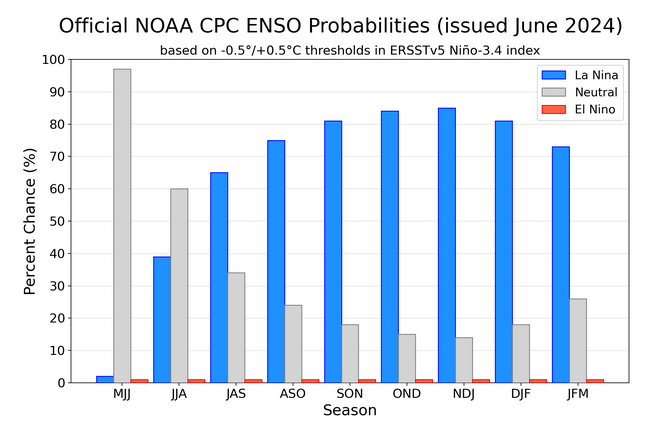
| It looks like ENSO is Neutral now and by summer we should be in La Nina which continues through the forecast period shown here but the full forecast in this article goes beyond next winter. This type of graphic does not show how strong an El Nino or a La Nina is likely to be. What is forecast is a La Nina that is stronger than a marginal La Nina but not very strong. |
Resources
Other Reports and Information
The Wildfire Report can be accessed HERE
–
| I hope you found this article interesting and useful. |
–
